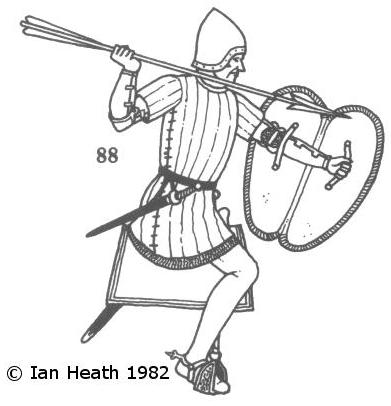
Try Amazon Audible Premium Plus and Get Up to Two Free Audiobooks
CASTILIAN JINETE
An extract from Armies of the Middle Ages, volume 1by Ian Heath



88. CASTILIAN JINETE
The javelin was very popular in Spain and was the principal weapon of the jinete. It is referred to by Froissart as la darde enpenné or jetan darde, the winged or throwing dart. He and others refer in addition to a light lance called an archegay which was also clearly a throwing weapon, which some have associated with the lancegay (lance agüe or launcegay, a type of short, light lance, sometimes thrown, introduced in the 14th century), while others have associated it with the assegai (derived from the Berber azagal). Froissart describes Granadine javelins at Montiel in 1369 as archegays. Regarding the javelins' effectiveness, he records that at Trancoso they 'were thrown with such force that they knocked down almost all they hit'; in an episode at the siege of Lisbon in 1384 a javelin pierced a knight's coat-of-plates, mail corselet, silk-stuffed gambeson and both sides of his body.
Jinetes of the very beginning of this period are described under figure 63 in Armies of Feudal Europe, where no armour at all is worn. Light armour, probably comprising just an aketon, may have come into use among jinetes soon afterwards, and was increased in weight in 1367 at du Guesclin's instigation in order that they might stand a better chance against the fire of the Black Prince's longbowmen. On the assumption that jinetes were supplied by the 3-20,000 maravedi category of Juan I's ordinance of arms of 1385, their equipment had by then been increased to lance, javelin, shield, haubergeon, gambeson, bascinet sans camail, capelina (a steel skull-cap, presumably here worn under the bascinet), sword, estoc and knife. The figure depicted here is based on such descriptions and a picture of Alvaro de Luna's victory at La Higueruela in 1431, where some have both leg and arm harness and most wear tabards like that of 85. It seems that 2-3 javelins were normally carried.
The shield is an adarge, usually constructed of several folds or layers of leather glued and sewn together. By the 15th century it might also be made of wood, and later even of steel.